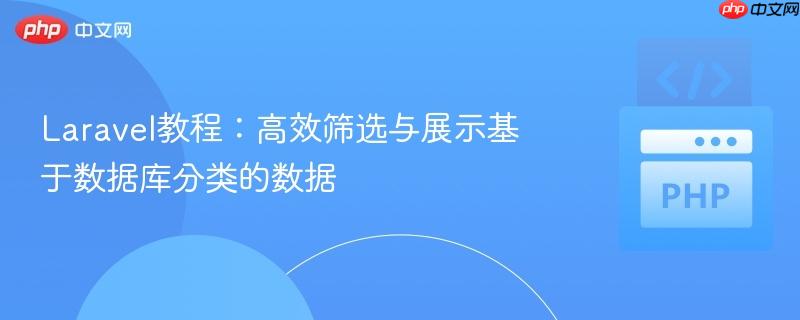
本文将详细介绍在laravel中如何根据数据库中存储的分类列表,高效地筛选并展示产品数据。我们将探讨两种主要方法:利用eloquent的`wherehas`和`wherein`进行数据库层面的优化查询,以及使用集合的`filter`方法进行应用层面的数据处理,帮助开发者根据实际场景选择最合适的过滤策略。
在Laravel应用开发中,我们经常面临需要根据特定条件筛选数据并将其展示在视图(Blade)上的需求。一个常见的场景是,我们有一个产品列表,需要根据一个动态的、存储在数据库中的分类列表来筛选这些产品。例如,我们可能希望只显示属于“书籍”或“衬衫”类别的产品,而这些允许的类别名称本身也存储在另一个数据库表中。
为了实现这一目标,Laravel提供了多种强大且灵活的工具,主要包括Eloquent ORM的关系查询和集合操作。选择哪种方法取决于数据集的大小、性能要求以及过滤逻辑的复杂性。
为了充分利用Laravel的强大功能,建议为您的数据库表创建对应的Eloquent模型并定义好关系。
假设我们有以下两个表:
对应的Eloquent模型和关系可能如下:
<?php
namespace App\Models;
use Illuminate\Database\Eloquent\Factories\HasFactory;
use Illuminate\Database\Eloquent\Model;
class Product extends Model
{
use HasFactory;
protected $fillable = ['name', 'description', 'category_id'];
/**
* 产品属于一个分类
*/
public function category()
{
return $this->belongsTo(Category::class);
}
}app/Models/Category.php
<?php
namespace App\Models;
use Illuminate\Database\Eloquent\Factories\HasFactory;
use Illuminate\Database\Eloquent\Model;
class Category extends Model
{
use HasFactory;
protected $fillable = ['name'];
/**
* 一个分类可以有多个产品
*/
public function products()
{
return $this->hasMany(Product::class);
}
}这是处理大型数据集时推荐的方法,因为它在数据库层面完成筛选,只检索符合条件的数据,从而减少了从数据库到应用服务器的数据传输量和内存消耗。
核心原理:
实现示例:
假设我们希望筛选出categories表中所有名称为“Book”或“Shirt”的分类所对应的产品。
<?php
namespace App\Http\Controllers;
use App\Models\Product;
use App\Models\Category;
use Illuminate\Http\Request;
class ProductController extends Controller
{
public function index(Request $request)
{
// 1. 从数据库中获取需要筛选的类别名称列表
// 假设我们有一个categories表,其中包含我们希望匹配的特定类别。
// 例如,我们可以从一个配置、另一个表或用户输入中获取这些类别。
// 这里我们模拟从categories表中获取特定名称的类别
$allowedCategoryNames = Category::whereIn('name', ['Book', 'Shirt'])->pluck('name')->toArray();
// 确保类别列表不为空,避免whereIn传入空数组导致SQL错误或意外结果
if (empty($allowedCategoryNames)) {
$products = collect(); // 返回空集合
} else {
// 2. 使用whereHas和whereIn进行数据库层面的筛选
$products = Product::whereHas('category', function ($query) use ($allowedCategoryNames) {
$query->whereIn('name', $allowedCategoryNames);
})->get();
}
// 3. 将筛选后的产品数据传递到Blade视图
return view('products.index', compact('products'));
}
}代码解析:
优点:
如果数据集相对较小,或者需要执行更复杂的、难以直接用SQL表达的过滤逻辑,可以使用Laravel集合的filter方法在应用层面进行筛选。
核心原理:
实现示例:
<?php
namespace App\Http\Controllers;
use App\Models\Product;
use App\Models\Category;
use Illuminate\Http\Request;
class ProductController extends Controller
{
public function index(Request $request)
{
// 1. 获取所有产品,并预加载分类关系以避免N+1问题
$allProducts = Product::with('category')->get();
// 2. 从数据库中获取需要筛选的类别名称列表
$allowedCategoryNames = Category::whereIn('name', ['Book', 'Shirt'])->pluck('name')->toArray();
// 3. 使用集合的filter方法进行应用层面的筛选
$filteredProducts = $allProducts->filter(function (Product $product) use ($allowedCategoryNames) {
// 确保产品有分类且分类名称在允许列表中
return $product->category && in_array($product->category->name, $allowedCategoryNames);
});
// 如果需要,可以重置集合的键
$products = $filteredProducts->values();
// 4. 将筛选后的产品数据传递到Blade视图
return view('products.index', compact('products'));
}
}代码解析:
优点:
缺点:
无论您选择哪种筛选方法,最终都会得到一个包含筛选后产品数据的Eloquent集合。您可以在Blade视图中轻松地迭代并展示这些数据:
resources/views/products/index.blade.php
<h1>产品列表</h1>
@if($products->isEmpty())
<p>没有找到匹配的产品。</p>
@else
<ul>
@foreach($products as $product)
<li>
<strong>{{ $product->name }}</strong>
@if($product->category)
<small>({{ $product->category->name }})</small>
@endif
<p>{{ $product->description }}</p>
</li>
@endforeach
</ul>
@endif在Laravel中根据数据库中存储的分类列表筛选产品数据,我们有两种主要策略:利用Eloquent的whereHas和whereIn进行数据库层面的高效查询,以及使用集合的filter方法进行应用层面的灵活处理。对于性能敏感或大数据量的场景,强烈推荐前者;而对于小数据集或需要复杂PHP逻辑的场景,后者则提供了更高的灵活性。理解这两种方法的优缺点,并根据实际需求选择最合适的方案,是构建高效、可维护Laravel应用的关键。
以上就是Laravel教程:高效筛选与展示基于数据库分类的数据的详细内容,更多请关注php中文网其它相关文章!

每个人都需要一台速度更快、更稳定的 PC。随着时间的推移,垃圾文件、旧注册表数据和不必要的后台进程会占用资源并降低性能。幸运的是,许多工具可以让 Windows 保持平稳运行。

Copyright 2014-2025 https://www.php.cn/ All Rights Reserved | php.cn | 湘ICP备2023035733号